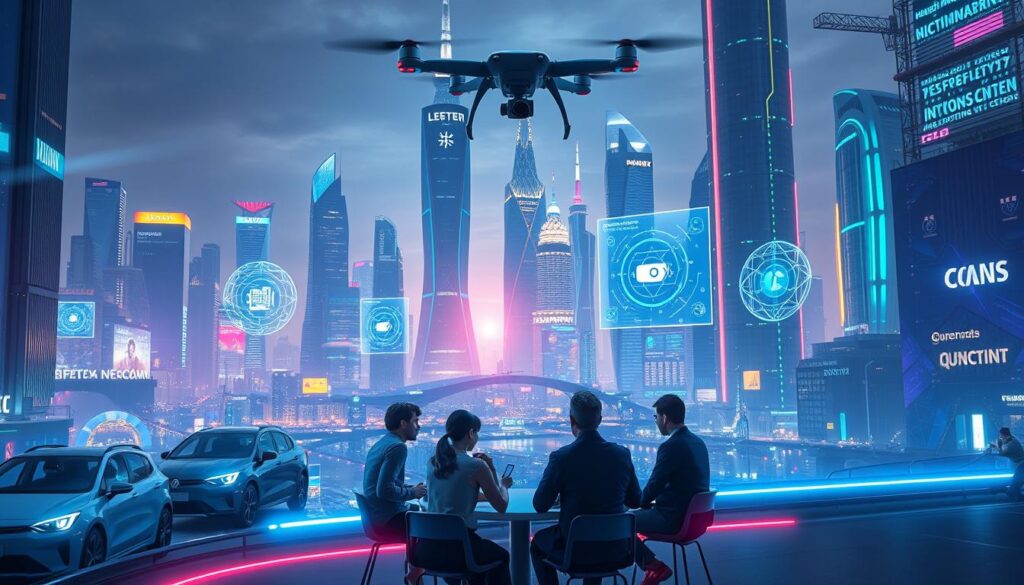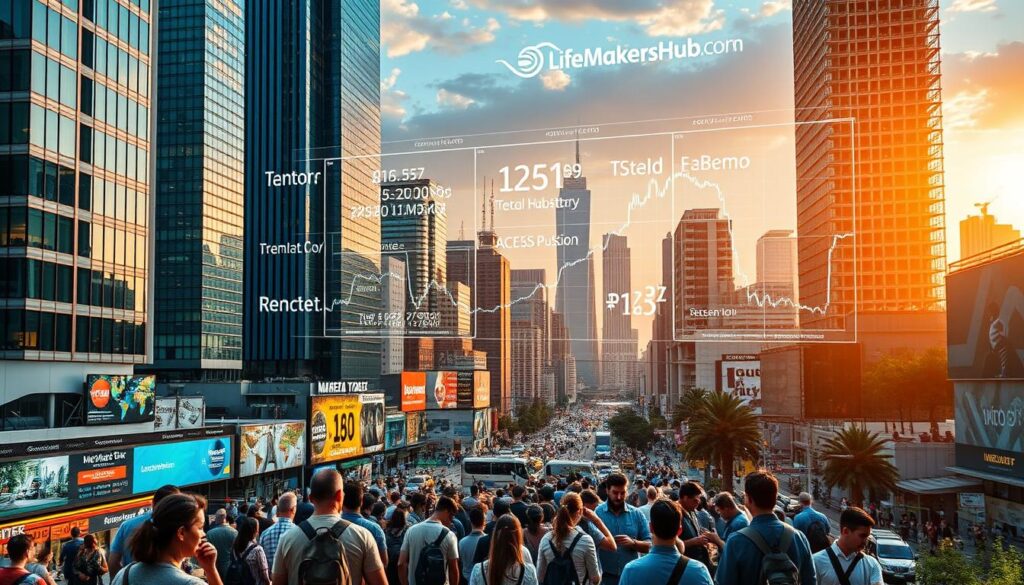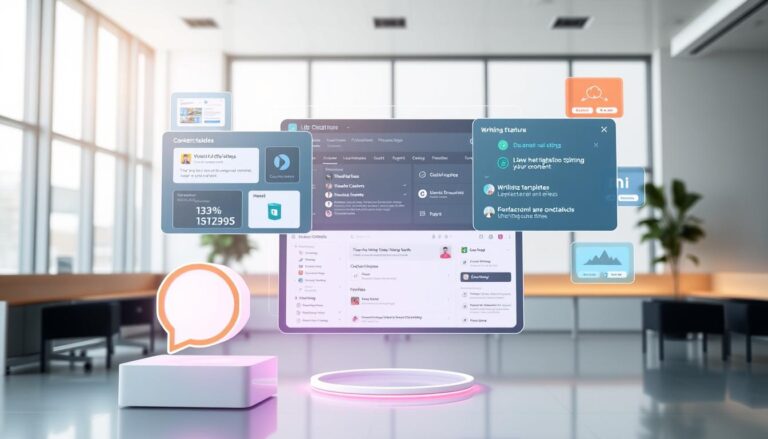Discover the Latest Tech Innovations Transforming Industries
The world is changing faster than ever, and technology is at the heart of this transformation. From artificial intelligence to quantum computing, new advancements are reshaping industries and everyday lives. These breakthroughs are not just headlines; they’re creating real-world impacts that businesses and individuals can’t ignore.
Emerging trends are redefining how we work, live, and interact. For example, AI is revolutionizing customer experiences, while eco-friendly practices are becoming a priority for companies worldwide. These changes are not just about staying competitive—they’re about building a better future.
From sci-fi-inspired breakthroughs to practical applications, the innovation landscape is full of exciting possibilities. Whether it’s enhancing efficiency or solving global challenges, technology is paving the way for progress. Stay tuned as we dive deeper into these transformative trends.
Key Takeaways
- Technology is driving rapid changes across industries.
- AI and quantum computing are leading the way in innovation.
- Eco-friendly practices are becoming a top priority for businesses.
- Emerging trends are reshaping both work and daily life.
- Stay informed to stay ahead in this evolving landscape.
Introduction: The Dawn of Technological Transformations
The pace of change in today’s world is reshaping industries at an unprecedented rate. From artificial intelligence to sustainable practices, advancements are not just altering how we work but also how we live. These shifts are creating opportunities for businesses and individuals alike.
The Value of Innovation in a Changing World
In a rapidly evolving world, innovation has become a cornerstone of success. Companies that embrace new ideas and tools are better positioned to thrive. For instance, AI-driven solutions are enhancing efficiency, while eco-friendly practices are meeting consumer demands for sustainability.
Historical examples show how transformative ideas have always driven progress. From the industrial revolution to the digital age, each leap forward has been fueled by creativity and adaptability. Today, the same principles apply, but the stakes are higher.
Overview of Emerging Tech Trends
Several trends are setting the pace for modern industries. Here’s a quick look at some of the most impactful developments:
| Trend | Impact |
|---|---|
| Artificial Intelligence | Enhancing decision-making and automation |
| Sustainable Practices | Reducing environmental footprints |
| Quantum Computing | Revolutionizing data processing |
| IoT Integration | Connecting devices for smarter solutions |
These trends are not just theoretical—they’re already making waves in the market. For example, AI is being used in classrooms to personalize learning, while IoT is transforming supply chains. The possibilities are endless, and the future is full of promise.
The Evolution of Technology and Business Innovation
Over the decades, technology has evolved alongside business strategies, creating a dynamic synergy. From the industrial revolution to the digital age, each era has brought transformative advancements. These changes have not only reshaped industries but also redefined how organizations operate.
Iterative improvements in tools and systems have played a crucial role. For example, the introduction of assembly lines in the early 20th century revolutionized manufacturing. Today, artificial intelligence and data analytics are driving similar shifts, enabling smarter decision-making and streamlined processes.
Companies like Apple and Tesla have harnessed innovative concepts to enhance their market value. Apple’s focus on user-friendly design and Tesla’s commitment to sustainable energy are prime examples. These businesses demonstrate how merging technology with creativity can lead to sustained growth.
Key conceptual shifts have also reshaped traditional business models. The rise of e-commerce, for instance, has transformed retail. Similarly, the adoption of cloud computing has made scalable solutions accessible to smaller enterprises. These changes highlight the importance of adaptability in a rapidly evolving industry.
Looking ahead, the integration of emerging tools like IoT and 5G will continue to drive progress. Businesses that embrace these advancements will be better positioned to thrive. The future of innovation lies in leveraging technology to solve complex challenges and create lasting value.
Harnessing tech innovation for Business Transformation
Businesses are leveraging cutting-edge tools to stay ahead in a competitive landscape. By adopting innovation, companies are transforming their operations and achieving remarkable results. These strategies are not just about adopting new tools but also about rethinking processes to maximize efficiency.
Collaborative teams play a crucial role in implementing these changes. When diverse skill sets come together, they create solutions that are both creative and effective. For example, companies like Amazon have used cross-functional teams to streamline their supply chains and improve delivery times.
Case studies highlight how businesses are adapting to digital shifts. One notable example is Starbucks, which uses AI to personalize customer experiences. By analyzing data, they offer tailored recommendations, enhancing customer satisfaction and loyalty.
Advancements in tech have directly improved service and operational efficiency. AI-driven chatbots, for instance, handle customer inquiries faster than human agents. This not only reduces costs but also ensures 24/7 support for customers.
An agile approach is essential for integrating new tools across services. Companies that continuously adapt to technological changes report a 50% higher rate of innovation. This flexibility allows them to respond quickly to market demands and stay competitive.
| Strategy | Outcome |
|---|---|
| AI Integration | Improved decision-making and efficiency |
| Cross-Functional Teams | Creative problem-solving and faster implementation |
| Personalized Customer Experiences | Higher engagement and loyalty |
| Agile Methodologies | Faster adaptation to market changes |
Understanding the Impact of Disruptive Technologies

Disruptive technologies are reshaping industries, challenging long-standing norms. These advancements force businesses to adapt or risk falling behind. From AI to blockchain, new tools are creating both opportunities and challenges.
One major challenge is the rapid pace of adoption. Companies must quickly integrate new systems while managing risks. For example, AI-driven solutions have revolutionized customer service but also raised concerns about data privacy.
Historical examples show how disruption can lead to success or failure. The printing press democratized knowledge, while the Segway failed to meet market expectations. These cases highlight the importance of aligning technology with consumer needs.
Businesses are mobilizing resources to stay competitive. Cross-functional teams and agile methodologies are becoming essential. Companies like Amazon and Starbucks have successfully navigated these changes by leveraging innovation.
Here’s a look at the risks and rewards of disruptive technologies:
| Technology | Risk | Reward |
|---|---|---|
| AI | Data privacy concerns | Enhanced decision-making |
| Blockchain | Regulatory hurdles | Secure transactions |
| IoT | Security vulnerabilities | Improved efficiency |
Disruption is an inevitable part of progress. By embracing change and leveraging innovation, companies can turn challenges into opportunities. The future belongs to those who adapt and evolve.
AI and Its Role in Shaping Future Industries
Artificial intelligence is no longer a futuristic concept—it’s reshaping industries today. From healthcare to logistics, AI tools are driving efficiency and solving complex challenges. These advancements are not just improving workflows but also redefining how businesses operate.
Breakthrough AI Tools and Their Applications
AI tools are making waves across various sectors. In healthcare, models like those used in radiology are shortening diagnostic timelines, enabling quicker interventions. This saves lives and improves patient outcomes.
In logistics, machine learning algorithms analyze traffic patterns and weather conditions to optimize supply chains. Companies like Tesla and Waymo are leading the development of self-driving technology, which promises to reduce accidents and lower emissions.
Finance is another area where AI is transforming operations. Advanced data analytics help detect fraud, conduct audits, and evaluate loan applications. These tools are not just efficient—they’re also reducing costs and improving accuracy.
Balancing Innovation with Security
While AI offers immense potential, it also raises security concerns. Cloud-based attacks and data privacy issues are growing challenges. Businesses must balance rapid innovation with robust security measures to protect sensitive information.
For example, 48% of businesses have entered non-public company information into generative AI tools, according to a 2024 Cisco survey. This highlights the need for stricter protocols to safeguard intellectual property and legal rights.
By adopting secure frameworks and staying vigilant, companies can harness AI’s power without compromising safety. This balance is crucial for sustainable growth in the future.
AI is not just a tool—it’s a game-changer. From enhancing productivity to solving global challenges, its impact is undeniable. As industries continue to evolve, embracing AI will be key to staying competitive and driving progress.
Sustainable Tech: Eco-Friendly Innovations and Practices
Sustainability is no longer a buzzword—it’s a necessity shaping the future of industries. From construction to design, eco-friendly innovations are transforming traditional practices. These advancements are not just about reducing environmental impact but also about creating smarter, more efficient solutions.
Mushroom Bricks and Mycelium-Based Materials
One of the most exciting developments in sustainable technology is the use of mushroom bricks and mycelium-based materials. These natural alternatives are made from fungi, offering a renewable and biodegradable option for construction. Unlike traditional materials, they require minimal energy to produce and can decompose naturally, reducing waste.
Mycelium, the root structure of mushrooms, grows quickly and can be molded into various shapes. This makes it ideal for creating bricks, insulation, and even furniture. Companies are already exploring its potential to replace plastics and other non-renewable resources.
The advantages of integrating these materials into modern practices are clear. They are lightweight, durable, and cost-effective. Plus, they address the growing challenge of reducing carbon footprints in industries like construction and manufacturing.
By embracing these innovations, businesses can contribute to a greener future while staying competitive. Sustainable practices are not just good for the planet—they’re also a smart way to meet consumer demands for eco-conscious solutions.
As industries continue to evolve, adopting sustainable technology will be key to long-term success. Whether it’s through mushroom bricks or other renewable resources, the possibilities are endless. Let’s work together to build a better, more sustainable world.
Integrating Advanced Technologies in Traditional Industries
Traditional industries are embracing advanced technologies to stay relevant in a fast-evolving market. From manufacturing to healthcare, these sectors are adopting modern solutions to enhance efficiency and remain competitive. The key lies in merging new tools with established practices to create a seamless transition.
Practical tools play a vital role in this modernization process. For example, IoT devices in manufacturing streamline production lines, while AI-powered systems in healthcare improve diagnostic accuracy. These innovations not only boost productivity but also reduce costs, making them essential for growth.
Real-world examples highlight the success of this integration. In logistics, companies like Amazon use IoT and RFID technologies to enhance supply chain visibility. Similarly, retailers leverage AI for inventory management, improving demand forecasting and reducing stock issues.
Upgrading service models with advanced innovations offers significant benefits. For instance, energy companies deploy IoT-enabled smart grids to monitor and regulate energy distribution more effectively. This not only improves efficiency but also supports sustainable practices.
Legacy industries are reinventing themselves through strategic adoption of new technology. By embracing change and leveraging modern tools, they can address challenges and unlock new opportunities. The future belongs to those who adapt and evolve.
The Synergy Between Market Trends and Technological Advances

The intersection of market trends and technological advances is reshaping industries globally. As new tools emerge, they create opportunities and challenges for businesses. Understanding this synergy is key to staying competitive in a fast-evolving world.
Investor Perspectives and Market Dynamics
Investors are increasingly focusing on how emerging technologies impact business models. For example, companies like Netflix and Peloton have seen their market shares fluctuate due to their ability—or inability—to adapt. Netflix’s share dropped from 49.72% in Q1 2022 to 44.21% in Q1 2023, highlighting the importance of staying ahead.
Timing is critical in responding to technological breakthroughs. Zoom’s decline in user base, as competitors integrated AI-powered features, shows how quickly the market can shift. Investors are now prioritizing companies that can innovate at the right time.
“The ability to adapt to technological changes is no longer optional—it’s essential for survival.”
Global trends are also driving demand for smarter solutions. For instance, the rise of generative AI has seen a 700% spike in Google searches from 2022 to 2023. This reflects a growing appetite for advanced intelligence tools across industries.
Here’s a look at how technological advancements are influencing market dynamics:
| Technology | Market Impact |
|---|---|
| Generative AI | Increased demand for AI-driven solutions |
| IoT | Improved supply chain efficiency |
| Cloud Computing | Scalable solutions for businesses |
| Renewable Energy | Shift towards sustainable practices |
By aligning with these trends, businesses can unlock new opportunities and drive growth. The synergy between markets and technology is not just a trend—it’s the foundation of the future.
Leveraging Data and Intelligence for Strategic Growth
In today’s data-driven world, leveraging intelligence is key to unlocking growth opportunities. Businesses that harness data effectively gain a competitive edge, enabling smarter decision-making and streamlined operations. By integrating advanced analytics and smart tools, companies can transform raw data into actionable insights.
One of the most impactful methods is predictive analytics. This tool uses historical data to anticipate future trends, helping businesses optimize inventory, detect fraud, and improve customer experiences. For example, retailers use predictive models to forecast demand, reducing overstock and stockouts.
Case studies highlight the transformative power of data-driven strategies. Companies like Netflix and Amazon have mastered the art of using analytics to personalize service and enhance user engagement. These examples demonstrate how data can drive operational efficiency and customer satisfaction.
However, integrating data analytics comes with its own set of challenges. Issues like data quality, security, and resource constraints can hinder progress. Organizations must invest in skilled teams and robust systems to overcome these obstacles and fully capitalize on their data potential.
Forward-thinking strategies are essential for sustained growth. By aligning data initiatives with market trends, businesses can stay ahead of the curve. For instance, adopting AI-powered analytics can provide real-time insights, enabling faster responses to changing demands.
As we move through this year and beyond, the role of data and intelligence will only grow. Companies that embrace these tools and strategies will be better positioned to thrive in an increasingly competitive landscape. The future belongs to those who can turn data into a strategic asset.
Start-Up Culture: Fostering Innovation in New Ventures
Small teams with big ideas are transforming industries through dynamic start-up cultures. These ventures thrive on creativity, adaptability, and a relentless drive to solve problems. By embracing bold strategies, they challenge traditional norms and pave the way for groundbreaking solutions.
At the heart of every successful start-up is an entrepreneurial spirit. This mindset encourages risk-taking, quick decision-making, and a focus on delivering value. For instance, Bengaluru, ranked 22nd globally in the Global Startup Ecosystem Report 2022, exemplifies how vibrant start-up hubs can drive change.
Entrepreneurial Spirit in Small Teams
Start-ups often operate with small, agile teams that foster collaboration and innovation. Each person plays a critical role, contributing unique skills and perspectives. This diversity fuels creativity and enables start-ups to tackle complex challenges effectively.
Take the example of Indian start-ups focusing on energy transition and green hydrogen. These ventures have revolutionized their industries by leveraging cutting-edge solutions. Their success highlights the importance of aligning innovation with market demands.
Timely innovation is another key factor. Start-ups that adapt quickly to emerging trends gain a competitive edge. For instance, India’s Global Innovation Index ranking improved to 40th in 2022, reflecting the growing impact of its start-up ecosystem.
By fostering a culture of experimentation and learning, start-ups continue to shape the future. Their ability to innovate rapidly ensures they remain relevant in an ever-changing year.
Emerging Tools and Digital Platforms Revolutionizing Services
Digital platforms and emerging tools are redefining how services are delivered, creating smarter and more efficient solutions. From ride-sharing apps to e-commerce giants, these advancements are transforming customer interactions and operational workflows.
One of the most significant shifts is the use of centralized and decentralized matching designs. Ride-sharing platforms like Uber prioritize safety and speed, while eBay allows buyers and sellers to connect directly. These models minimize search costs and enhance user autonomy.
Artificial intelligence plays a pivotal role in personalizing these platforms. AI-powered tools analyze user data to offer tailored recommendations, improving engagement and satisfaction. For instance, Netflix uses AI to suggest content, while Amazon personalizes shopping experiences.
Dynamic pricing is another innovation reshaping industries. Platforms like Airbnb and Instacart adjust prices in real-time based on demand, inventory, and other factors. This approach ensures fair pricing while optimizing revenue.
As we move through this year, the evolution of digital platforms continues to accelerate. Low-code and no-code tools empower businesses to manage processes independently, while the metaverse introduces immersive customer experiences. These advancements highlight the ongoing integration of intelligence into everyday services.
| Tool/Platform | Impact |
|---|---|
| Ride-Sharing Apps | Optimized matching and pricing |
| E-Commerce Platforms | Personalized shopping experiences |
| Dynamic Pricing Models | Real-time price adjustments |
| Low-Code Tools | Streamlined process management |
The future of service delivery lies in leveraging these tools to create seamless, user-centric experiences. By embracing digital platforms and AI-driven solutions, businesses can stay ahead in an ever-evolving landscape.
Navigating Regulatory Landscapes in a Tech-Driven World

Regulatory challenges are becoming a central focus for businesses in a rapidly evolving digital landscape. As industries adopt advanced tools, understanding and complying with legal frameworks is essential. Companies that fail to adapt risk penalties, reputational damage, and operational disruptions.
Adapting to Industry Standards and Legal Frameworks
Staying compliant requires a proactive approach. Businesses must monitor changes in regulations and implement strategies to meet new standards. For example, the US Department of the Treasury’s restrictions on investments in China’s AI sector highlight how geopolitical factors influence compliance.
One effective strategy is investing in RegTech solutions. These tools use AI and automation to streamline compliance processes, reducing human error and improving efficiency. According to research, 11% of institutions are adopting Natural Language Processing (NLP) as a core component of their compliance systems.
Common problems include data privacy concerns and cybersecurity risks. The global average cost of a data breach in 2023 was $4.45 million, emphasizing the need for robust security measures. Companies that prioritize compliance can mitigate these risks and protect their assets.
Real-world examples show how regulatory changes impact business strategies. For instance, the adoption of GDPR in Europe forced companies worldwide to revamp their data handling practices. This shift not only ensured compliance but also enhanced customer trust.
Understanding the concept of dynamic compliance is crucial. Regulations evolve alongside technological advancements, requiring businesses to remain agile. By aligning compliance strategies with market trends, companies can stay ahead of the curve.
| Challenge | Solution |
|---|---|
| Data Privacy | Implement AI-driven security tools |
| Cybersecurity Risks | Adopt RegTech solutions |
| Regulatory Changes | Monitor updates and adapt quickly |
| Geopolitical Factors | Align strategies with global standards |
Navigating regulatory landscapes is not just about avoiding penalties—it’s about building trust and ensuring long-term success. By embracing compliance as a strategic priority, businesses can thrive in a tech-driven world.
Empowering Teams Through Collaborative Innovation
Collaboration is the heartbeat of modern success, driving teams to achieve remarkable results. When individuals come together with a shared vision, they can tackle complex challenges and create transformative solutions. This synergy is the heart of progress in any field.
Fostering a collaborative environment accelerates innovation. Teams that communicate openly and value diverse perspectives often find creative solutions faster. For example, companies like Google have thrived by encouraging cross-functional collaboration and psychological safety among employees.
Passionate teams are the driving force behind groundbreaking projects. When individuals are deeply committed to a shared goal, they push boundaries and explore new possibilities. This dedication is the heart of every successful venture.
Here are some key benefits of collaborative innovation:
- Enhanced problem-solving through diverse perspectives.
- Faster implementation of ideas with shared responsibilities.
- Increased employee engagement and satisfaction.
- Stronger alignment with organizational goals.
Encouraging a culture of open dialogue and collective problem-solving is essential. When team members feel valued and heard, they contribute their best ideas. This concept of inclusivity fosters creativity and drives long-term success.
By empowering teams and nurturing collaboration, businesses can unlock their full potential. The future belongs to those who embrace the power of working together.
The Role of Artificial Intelligence in Enhancing Customer Experience

Artificial intelligence is revolutionizing how businesses connect with their customers. By analyzing data and predicting needs, AI creates personalized experiences that foster loyalty and satisfaction. This transformation is reshaping industries, from retail to healthcare, making every interaction smarter and more efficient.
One of the most significant impacts of AI is its ability to handle customer inquiries quickly and accurately. For example, chatbots powered by artificial intelligence can resolve up to 80% of routine issues, reducing wait times by 50%. This not only improves efficiency but also allows human agents to focus on more complex tasks.
Case studies highlight the power of AI-driven personalization. Companies like Netflix and Amazon use AI to analyze user behavior and offer tailored recommendations. This approach has led to a 20% increase in customer satisfaction scores, proving that personalization is key to building lasting relationships.
However, the human touch remains essential. While AI can handle many tasks, customers still value empathy and understanding. A 2023 survey found that 188% of employees felt a reduction in perceived empathy when AI tools were implemented. This highlights the need to balance automation with genuine human connection.
Looking ahead, AI will continue to redefine customer interaction. By 2025, 95% of all customer interactions are expected to be supported by AI. This includes predictive analytics, which can anticipate customer needs before they arise, creating a seamless and proactive experience.
In conclusion, artificial intelligence is transforming customer experience by making it more personalized and efficient. Yet, the heart of every interaction remains the person behind the screen. By striking the right balance, businesses can create meaningful connections that drive long-term success.
Global Perspectives on Tech Innovation and Market Shifts
Global advancements are reshaping industries, creating a ripple effect across markets. From the US to Asia, technological changes are influencing how businesses operate and compete. These shifts are not isolated; they reflect a broader trend of interconnectedness in the world.
In the US, the market is seeing a surge in AI adoption and renewable energy investments. Companies are leveraging these tools to stay competitive and meet consumer demands. For example, the automotive industry is undergoing a transformation with the rise of electric vehicles, or cars, designed for sustainability.
Internationally, regions like Southeast Asia and Europe are also making strides. Countries such as South Korea and Switzerland are leading in innovation, as highlighted by the Global Innovation Index. These trends show how timing and strategic investments play a crucial role in shaping the future.
Here’s a snapshot of global innovation trends:
- US leads in AI and renewable energy adoption.
- South Korea ranks 6th in global innovation.
- Switzerland tops the Global Innovation Index for 12 consecutive years.
As industries evolve, the world becomes more interconnected. Businesses that adapt to these changes will thrive, while those that lag behind risk falling out of the race. The key lies in understanding global trends and aligning strategies with the right time and opportunities.
Conclusion
As we move forward, the way industries operate continues to evolve at a rapid pace. This year, we’ve explored how advancements are reshaping every part of the world, from market trends to consumer experiences. Artificial intelligence, sustainability, and new tools have become essential resources for businesses aiming to stay competitive.
Throughout this journey, one thing is clear: the way we approach problems is changing. Companies are no longer just adapting; they’re leading the charge with creative solutions. Staying updated with the latest news and trends is crucial for anyone looking to thrive in this dynamic landscape.
From the rise of electric cars to smarter time management strategies, the future is being shaped by those who embrace change. Let’s continue to innovate and tackle challenges head-on, ensuring progress for years to come.
FAQ
How is artificial intelligence transforming industries?
What are some eco-friendly tech innovations?
How can businesses integrate advanced technologies?
What challenges do regulators face in a tech-driven world?
How do start-ups foster innovation in the tech industry?
What role does data play in strategic growth?
How can teams collaborate effectively in tech innovation?
What are the latest trends in the global tech market?
Source Links
- Tech Trends 2025
- 20 Game-Changing Innovations Set To Transform Industries In 2025
- What is digital transformation?
- Leading Change for Digital Transformation – Integrated Innovation Institute – Carnegie Mellon University
- Digital technology and social change: the digital transformation of society from a historical perspective
- History of technology | Evolution, Ages, & Facts | Britannica
- The Evolution of Technology: A Journey from Innovation to Integration
- How To Harness Technology To Propel Business Success And Employee Satisfaction
- Harnessing AI and tech innovations : A roadmap for business transformation
- Technology Strategy
- Disruptive Technology: Definition, Example, and How to Invest
- The Impact of Disruptive Technology: Historical & Modern Examples
- Disruptive Innovation: The Theory Behind How It Works and Its Impact on Society
- How AI Is Reshaping The Future Of Work Across Industries
- The Future of AI: How AI Is Changing the World | Built In
- Sustainable Technology: Examples, Benefits And Challenges
- Green Tech: 5 Sustainability Innovations in the Tech Industry
- Sustainable Innovation & Technology – Google Sustainability
- How Digital Transformation is Reshaping Traditional Industries
- Digital Transformation: Empowering Traditional Industries with Cutting-Edge Technologies
- How Innovation and Competitive Advantage Connect | StartUs Insights
- McKinsey technology trends outlook 2024
- How innovative companies leverage tech to outperform
- Leveraging data analytics for business growth
- Leveraging Data as a Product: Strategies for Growth with Liat Ben-Zur
- How Tech Leaders Can Foster A Culture Of Practical Innovation
- How The Maturing Startup Culture Is Fostering Innovation?
- Digital Platforms: What They Are & How They Create Value
- 20 Emerging Tech Tools And Trends Everyone Should Know About
- Navigating Tech’s Next Frontier: AI, Efficiency, Regulatory
- The CFO’s Guide to Navigating Regulatory Compliance in a Technology-Driven Environment – Practus: Results. Delivered
- Fostering Innovation Through Collaboration: A Comprehensive Guide
- Transforming Work Culture: Collaborative Leadership for Innovation
- Innovation In Action: 19 Tips For Empowering Tech Teams
- How AI Is Revolutionizing Customer Experience
- The Role of Artificial Intelligence in Customer Experience – 3Pillar
- How will AI impact the customer experience?
- Technology and the Innovation Economy
- State of Global Innovation: 2023 Insights & Perspectives | Vation Ventures Research
- What does technological innovation really consist of? | SEIDOR
- How Are Technology and Innovation Interrelated? | Cypris
- How Do Technologies Speed Up the Innovation Process? | Cypris







